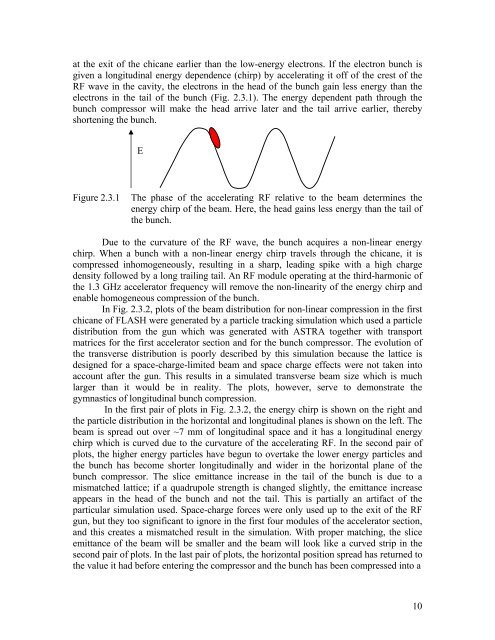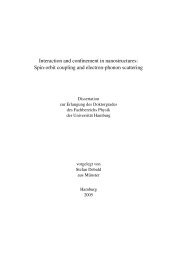Measuring the Electron Beam Energy in a Magnetic Bunch ... - DESY
Measuring the Electron Beam Energy in a Magnetic Bunch ... - DESY
Measuring the Electron Beam Energy in a Magnetic Bunch ... - DESY
You also want an ePaper? Increase the reach of your titles
YUMPU automatically turns print PDFs into web optimized ePapers that Google loves.
at <strong>the</strong> exit of <strong>the</strong> chicane earlier than <strong>the</strong> low-energy electrons. If <strong>the</strong> electron bunch is<br />
given a longitud<strong>in</strong>al energy dependence (chirp) by accelerat<strong>in</strong>g it off of <strong>the</strong> crest of <strong>the</strong><br />
RF wave <strong>in</strong> <strong>the</strong> cavity, <strong>the</strong> electrons <strong>in</strong> <strong>the</strong> head of <strong>the</strong> bunch ga<strong>in</strong> less energy than <strong>the</strong><br />
electrons <strong>in</strong> <strong>the</strong> tail of <strong>the</strong> bunch (Fig. 2.3.1). The energy dependent path through <strong>the</strong><br />
bunch compressor will make <strong>the</strong> head arrive later and <strong>the</strong> tail arrive earlier, <strong>the</strong>reby<br />
shorten<strong>in</strong>g <strong>the</strong> bunch.<br />
E<br />
Figure 2.3.1 The phase of <strong>the</strong> accelerat<strong>in</strong>g RF relative to <strong>the</strong> beam determ<strong>in</strong>es <strong>the</strong><br />
energy chirp of <strong>the</strong> beam. Here, <strong>the</strong> head ga<strong>in</strong>s less energy than <strong>the</strong> tail of<br />
<strong>the</strong> bunch.<br />
Due to <strong>the</strong> curvature of <strong>the</strong> RF wave, <strong>the</strong> bunch acquires a non-l<strong>in</strong>ear energy<br />
chirp. When a bunch with a non-l<strong>in</strong>ear energy chirp travels through <strong>the</strong> chicane, it is<br />
compressed <strong>in</strong>homogeneously, result<strong>in</strong>g <strong>in</strong> a sharp, lead<strong>in</strong>g spike with a high charge<br />
density followed by a long trail<strong>in</strong>g tail. An RF module operat<strong>in</strong>g at <strong>the</strong> third-harmonic of<br />
<strong>the</strong> 1.3 GHz accelerator frequency will remove <strong>the</strong> non-l<strong>in</strong>earity of <strong>the</strong> energy chirp and<br />
enable homogeneous compression of <strong>the</strong> bunch.<br />
In Fig. 2.3.2, plots of <strong>the</strong> beam distribution for non-l<strong>in</strong>ear compression <strong>in</strong> <strong>the</strong> first<br />
chicane of FLASH were generated by a particle track<strong>in</strong>g simulation which used a particle<br />
distribution from <strong>the</strong> gun which was generated with ASTRA toge<strong>the</strong>r with transport<br />
matrices for <strong>the</strong> first accelerator section and for <strong>the</strong> bunch compressor. The evolution of<br />
<strong>the</strong> transverse distribution is poorly described by this simulation because <strong>the</strong> lattice is<br />
designed for a space-charge-limited beam and space charge effects were not taken <strong>in</strong>to<br />
account after <strong>the</strong> gun. This results <strong>in</strong> a simulated transverse beam size which is much<br />
larger than it would be <strong>in</strong> reality. The plots, however, serve to demonstrate <strong>the</strong><br />
gymnastics of longitud<strong>in</strong>al bunch compression.<br />
In <strong>the</strong> first pair of plots <strong>in</strong> Fig. 2.3.2, <strong>the</strong> energy chirp is shown on <strong>the</strong> right and<br />
<strong>the</strong> particle distribution <strong>in</strong> <strong>the</strong> horizontal and longitud<strong>in</strong>al planes is shown on <strong>the</strong> left. The<br />
beam is spread out over ~7 mm of longitud<strong>in</strong>al space and it has a longitud<strong>in</strong>al energy<br />
chirp which is curved due to <strong>the</strong> curvature of <strong>the</strong> accelerat<strong>in</strong>g RF. In <strong>the</strong> second pair of<br />
plots, <strong>the</strong> higher energy particles have begun to overtake <strong>the</strong> lower energy particles and<br />
<strong>the</strong> bunch has become shorter longitud<strong>in</strong>ally and wider <strong>in</strong> <strong>the</strong> horizontal plane of <strong>the</strong><br />
bunch compressor. The slice emittance <strong>in</strong>crease <strong>in</strong> <strong>the</strong> tail of <strong>the</strong> bunch is due to a<br />
mismatched lattice; if a quadrupole strength is changed slightly, <strong>the</strong> emittance <strong>in</strong>crease<br />
appears <strong>in</strong> <strong>the</strong> head of <strong>the</strong> bunch and not <strong>the</strong> tail. This is partially an artifact of <strong>the</strong><br />
particular simulation used. Space-charge forces were only used up to <strong>the</strong> exit of <strong>the</strong> RF<br />
gun, but <strong>the</strong>y too significant to ignore <strong>in</strong> <strong>the</strong> first four modules of <strong>the</strong> accelerator section,<br />
and this creates a mismatched result <strong>in</strong> <strong>the</strong> simulation. With proper match<strong>in</strong>g, <strong>the</strong> slice<br />
emittance of <strong>the</strong> beam will be smaller and <strong>the</strong> beam will look like a curved strip <strong>in</strong> <strong>the</strong><br />
second pair of plots. In <strong>the</strong> last pair of plots, <strong>the</strong> horizontal position spread has returned to<br />
<strong>the</strong> value it had before enter<strong>in</strong>g <strong>the</strong> compressor and <strong>the</strong> bunch has been compressed <strong>in</strong>to a<br />
10

















